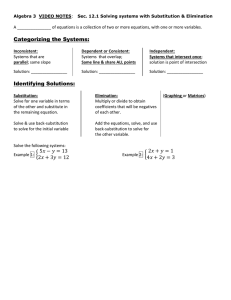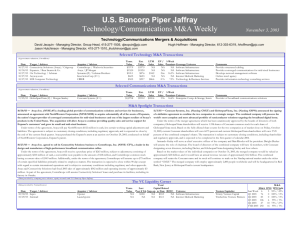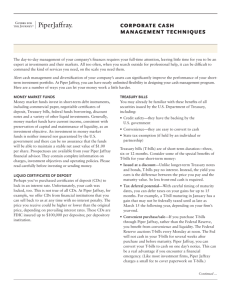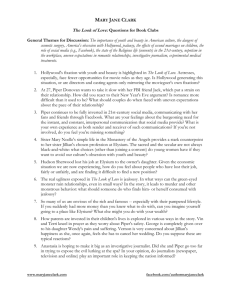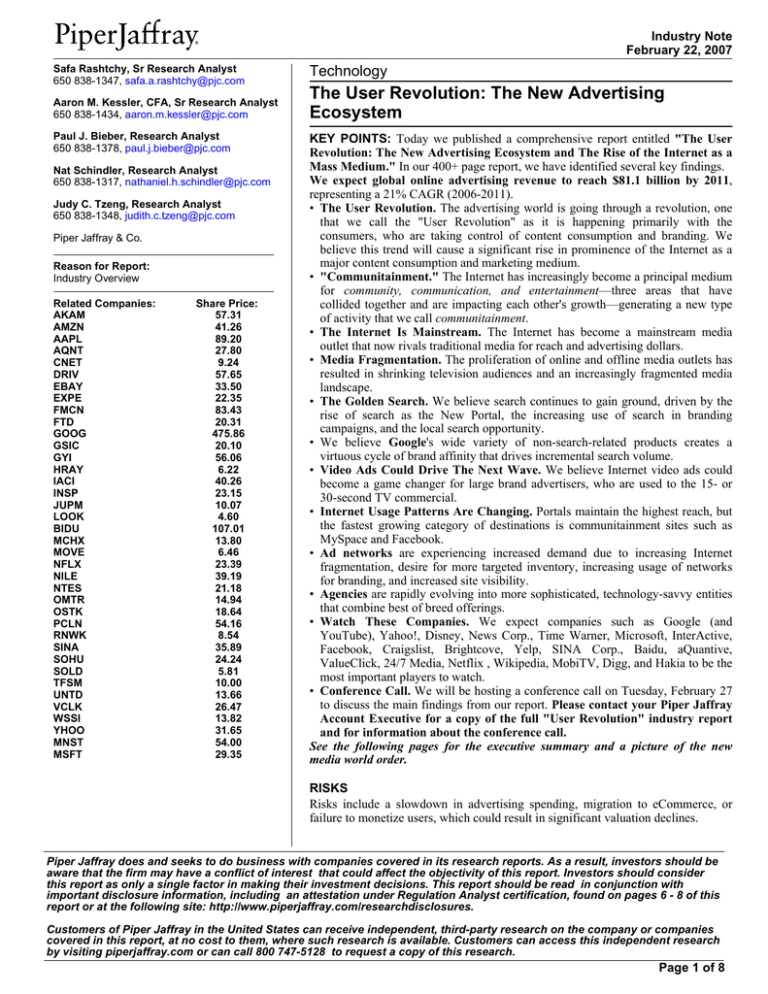
Industry Note
February 22, 2007
Safa Rashtchy, Sr Research Analyst
650 838-1347, safa.a.rashtchy@pjc.com
Aaron M. Kessler, CFA, Sr Research Analyst
650 838-1434, aaron.m.kessler@pjc.com
Paul J. Bieber, Research Analyst
650 838-1378, paul.j.bieber@pjc.com
Nat Schindler, Research Analyst
650 838-1317, nathaniel.h.schindler@pjc.com
Judy C. Tzeng, Research Analyst
650 838-1348, judith.c.tzeng@pjc.com
Piper Jaffray & Co.
Reason for Report:
Industry Overview
Related Companies:
AKAM
AMZN
AAPL
AQNT
CNET
DRIV
EBAY
EXPE
FMCN
FTD
GOOG
GSIC
GYI
HRAY
IACI
INSP
JUPM
LOOK
BIDU
MCHX
MOVE
NFLX
NILE
NTES
OMTR
OSTK
PCLN
RNWK
SINA
SOHU
SOLD
TFSM
UNTD
VCLK
WSSI
YHOO
MNST
MSFT
Share Price:
57.31
41.26
89.20
27.80
9.24
57.65
33.50
22.35
83.43
20.31
475.86
20.10
56.06
6.22
40.26
23.15
10.07
4.60
107.01
13.80
6.46
23.39
39.19
21.18
14.94
18.64
54.16
8.54
35.89
24.24
5.81
10.00
13.66
26.47
13.82
31.65
54.00
29.35
Technology
The User Revolution: The New Advertising
Ecosystem
KEY POINTS: Today we published a comprehensive report entitled "The User
Revolution: The New Advertising Ecosystem and The Rise of the Internet as a
Mass Medium." In our 400+ page report, we have identified several key findings.
We expect global online advertising revenue to reach $81.1 billion by 2011,
representing a 21% CAGR (2006-2011).
• The User Revolution. The advertising world is going through a revolution, one
that we call the "User Revolution" as it is happening primarily with the
consumers, who are taking control of content consumption and branding. We
believe this trend will cause a significant rise in prominence of the Internet as a
major content consumption and marketing medium.
• "Communitainment." The Internet has increasingly become a principal medium
for community, communication, and entertainment—three areas that have
collided together and are impacting each other's growth—generating a new type
of activity that we call communitainment.
• The Internet Is Mainstream. The Internet has become a mainstream media
outlet that now rivals traditional media for reach and advertising dollars.
• Media Fragmentation. The proliferation of online and offline media outlets has
resulted in shrinking television audiences and an increasingly fragmented media
landscape.
• The Golden Search. We believe search continues to gain ground, driven by the
rise of search as the New Portal, the increasing use of search in branding
campaigns, and the local search opportunity.
• We believe Google's wide variety of non-search-related products creates a
virtuous cycle of brand affinity that drives incremental search volume.
• Video Ads Could Drive The Next Wave. We believe Internet video ads could
become a game changer for large brand advertisers, who are used to the 15- or
30-second TV commercial.
• Internet Usage Patterns Are Changing. Portals maintain the highest reach, but
the fastest growing category of destinations is communitainment sites such as
MySpace and Facebook.
• Ad networks are experiencing increased demand due to increasing Internet
fragmentation, desire for more targeted inventory, increasing usage of networks
for branding, and increased site visibility.
• Agencies are rapidly evolving into more sophisticated, technology-savvy entities
that combine best of breed offerings.
• Watch These Companies. We expect companies such as Google (and
YouTube), Yahoo!, Disney, News Corp., Time Warner, Microsoft, InterActive,
Facebook, Craigslist, Brightcove, Yelp, SINA Corp., Baidu, aQuantive,
ValueClick, 24/7 Media, Netflix , Wikipedia, MobiTV, Digg, and Hakia to be the
most important players to watch.
• Conference Call. We will be hosting a conference call on Tuesday, February 27
to discuss the main findings from our report. Please contact your Piper Jaffray
Account Executive for a copy of the full "User Revolution" industry report
and for information about the conference call.
See the following pages for the executive summary and a picture of the new
media world order.
RISKS
Risks include a slowdown in advertising spending, migration to eCommerce, or
failure to monetize users, which could result in significant valuation declines.
Piper Jaffray does and seeks to do business with companies covered in its research reports. As a result, investors should be
aware that the firm may have a conflict of interest that could affect the objectivity of this report. Investors should consider
this report as only a single factor in making their investment decisions. This report should be read in conjunction with
important disclosure information, including an attestation under Regulation Analyst certification, found on pages 6 - 8 of this
report or at the following site: http://www.piperjaffray.com/researchdisclosures.
Customers of Piper Jaffray in the United States can receive independent, third-party research on the company or companies
covered in this report, at no cost to them, where such research is available. Customers can access this independent research
by visiting piperjaffray.com or can call 800 747-5128 to request a copy of this research.
Page 1 of 8
Industry Note
February 22, 2007
Executive Summary
Birth of a New Era In Advertising. We are living through pivotal times in the advertising world, which is marked by the end of one
era—the golden age of advertising that began after the end of World War II—and the beginning of a new era. This new era can also be
termed a golden age, but not necessarily for the advertiser. It is the golden era for consumers, and it is already impacting advertising
far more profoundly than any other development over the last 50 years. These changes are driven by what we call the User Revolution.
Like many major social trends, the changes will not happen overnight, and we expect the User Revolution, which has just begun, to
last several years before the new regime is fully established and the old statues have all been toppled.
Five-Year Growth Estimates For Internet Advertising: Over 20% CAGR. For the Internet sector, the new era is a welcome
change as the Internet's most important characteristics, flexibility and user control, are also the hallmarks of the User Revolution. (In
fact, the Web been a major instigator of this user uprising.) As such, we believe the Internet will assume a premium position in the
new regime of media consumption. This is in part why we believe our new estimates for global online ad spending may prove overly
conservative. We estimate a 20% CAGR over the next five years, far outpacing all other major sectors of media and advertising. We
believe global online ad spending, now around $32 billion (in 2006), will exceed $80 billion by 2011. We note that every year for the
past three years, we have had to increase our estimates based on the faster growth rates in the online ad sector than we had originally
predicted.
The Revolution Is About Control. The uprising by the users is over control—control of the type of content users want, control of the
place and time content is delivered, control of the advertisements that the users are willing to take, and control of the brands they
want to create. Unlike most revolutions, where the masses revolt because of major hardship and grievances, the User Revolution was
largely driven by the proliferation of media options, the emergence of the Internet, and the growing sophistication of consumers.
The Picture Of The Media World In The New Regime
In the new era, we expect the following:
(1) search will assume an even more central role; (2) the distinction between traditional and new media will disappear; (3) consumers
will use an increasing and large number of Websites, TV channels, and other sources; (4) consumers will design their own content and
programming, and companies that enable and encourage this will prosper; (5) social networking sites will continue to grow and
potentially become the new portals; (6) users will select most products and services they buy based heavily on reviews and ratings (by
other users and experts), changing the impact of traditional ways of advertising; (7) video will be the killer app of the Web,
supplementing or taking over most other types of content; (8) simplicity, speed, intuitiveness, and usefulness will be the key attributes
of the successful media channels; and (9) multi-tasking and multi-channel use will be the norm.
Page 2 of 8
Industry Note
February 22, 2007
Source: Piper Jaffray & Co.
In this new media reality, companies will need to own or partner with many channels to be omnipresent with the users, forcing media
companies to cooperate much more on standards, realizing that the user is king.
The Drivers Of The User Revolution
We have identified six major trends in the media world and the Internet that define the User Revolution. These are as follows:
•
•
•
•
•
The Emergence of Communitainment – the combination of communication with entertainment and community
The Increasing Popularity of Usites – Websites with predominantly user generated content will flourish
Mainstreaming of the Internet – the Web is now a routine media channel for most demographic groups
Evolution of User-Generated Brands – users are taking control of both the promotion and definition of brands
Declining Usage of Traditional Media – consumers are spending less time on TV and newspapers in particular; simultaneous
media usage makes traditional media less effective for the advertiser
• Fragmentation of Content Consumption – consumers are using an increasing number of channels both offline and online in order
to get content from their "best-of-the breed" source; larger networks are losing out
Page 3 of 8
Industry Note
February 22, 2007
Communitainment and Usites are the most serious threat to the traditional method of content consumption (online or offline) and are
the hallmark of this User Revolution. For example, how does a site like Yelp merge merchant reviews and social networking to
become an online phenomenon, growing from 200,000 unique visitors in February 2006 to more than 800,000 in December 2006?
Similarly, where are young people getting the time to spend one to three hours a day on MySpace? On what other activities and media
sources are they cutting back? Finally, why is this type of activity—combining entertainment with communication with a group of
like-minded friends—so popular and does it indicate the next stage in media usage, which is going from the shared experience of the
early days of network TV to the more individualized preferences of cable TV and Tivo, and finally to the shared experience of fully
connected virtual networks. The new regime has people "Googling," YouTubing," "Yelping," "MySpacing," and, of course
IMing/chatting, while at the same time they are sharing their favorite songs, movies, stores, and destinations with each other.
Communitainment is the major achievement of the User Revolution, and it could replace other activities unless media companies
acknowledge this trend and opportunistically embrace it.
Traditional Media. The growth and popularity of communitainment is in direct contrast to the declining value of traditional media, as
reflected in the decreasing use of TV, newspapers, and other sources. In our 2006 Online Media Survey, 40% of the respondents said
they watch less TV than they did two years ago, while less than 18% said they watched more.
Search and Google Dominate the Internet. While consumers are spending far less time and attention on TV and newspapers, they
are busy searching, or more accurately, Googling, as Google's share of search continues to rise, and we except this trend to continue
for some time. We believe Google can eventually achieve 70%-80% market share both in the United States and worldwide. Search
itself has become the new portal model, as many users now rely on search to navigate the Web and find answers to their questions.
Searching is no longer just used to find information or to buy a product; search is the way people navigate the Internet.
We believe Google is the most important company to watch over the next 10 years in the Internet, as the User Revolution fully
unfolds. The combination of Google's strong market share and brand in search and the company's aggressive innovative strategy on
new products aligns Google more than any other company with the new User-based media.
What Are Media Companies to Do? The upshot of the above trends, which we discuss in detail in this report, is that both advertisers
and publishers need to change their strategies, and in some cases, their business models.
Publishers need to realize that their competition is no longer the other publishers, but a range of what we would call content and
services destinations. Many of these, such as Flicker, Yelp, or YouTube, are not considered publishers in the traditional sense yet they
pull consumer attention away from the traditional publishers. Thus, both traditional media channels and Internet sites have to adapt to
user control and content, as well as to consumers' desire to go to smaller, more specialized content sources. This requires new thinking
for many companies, and it gives an advantage to the so-called "Web 2.0" firms, such as Google, which are inherently much more
user-focused.
The Web's Darwinism. Successful online destinations (we prefer to use destinations rather than the word "publisher" as we believe
the latter does not accurately describe the networks on the Web today) will need to embrace users and transition their business models
away from providing content and services in return for advertising to a business model that is focused on creating cohesive
communities of users that generate ideas, content, and, most importantly, brands. The next task of these destinations is to match the
best advertisers with the user groups, allowing the content to get richer and more relevant for the users, and enabling the advertisers to
engage their target group in their brand. Providing news or entertainment is now a commodity, and successful destinations need to go
well beyond this, looking into the needs of the modern Internet users. The "portal," as we know it, is effectively dead. Users now do
not need a single destination that provides every type of service or content with effective search tools; they can navigate to
best-of-breed destinations and tools. The successful destinations of the next ten years will be agile and aggressive networks of smaller
sites with specific applications that are highly tailored to user needs. With users becoming much more sophisticated, we have become
more convinced that only the fittest will survive and Web Darwinism will play out over the next five years as the User Revolution
fully unfolds.
Advertisers need to adapt to the new consumer demands and match their services closely with consumer needs. The old advertising
adage that advertising is about "convincing consumers to buy what they don't know they need" has to change. Consumers largely
know what they need, and they want messages that are targeted at those specific needs. They also want to associate the brand with
their lifestyle, and in doing so, they will become evangelizers for that brand. Thus advertisers need to forge closer relationships with
consumers – close enough to be part of the content they are consuming, not just a commercial interruption of the content. In the new
regime, advertisers must not only follow customer cues, they must also join their networks as active participants with a genuine
Page 4 of 8
Industry Note
February 22, 2007
interest in promoting consumers' interests. This is probably one of the most radical changes that the User Revolution will cause in the
advertising world, but we believe the most successful businesses in the next 20 years will be those who are fully aligned with
consumers' social ideals.
****Please contact your Piper Jaffray Account Executive for a copy of the full "User
Revolution" industry report *****
Page 5 of 8
Industry Note
February 22, 2007
Important Research Disclosures
Distribution of Ratings/IB Services
Piper Jaffray
IB Serv./Past 12 Mos.
Rating
BUY [OP]
HOLD [MP]
SELL [UP]
Count
357
246
29
Percent
56.49
38.92
4.59
Count
89
20
2
Percent
24.93
8.13
6.90
Note: Distribution of Ratings/IB Services shows the number of companies in each rating category from which Piper Jaffray and its affiliates received
compensation for investment banking services within the past 12 months. NASD and NYSE rules require disclosure of which ratings most closely correspond
with "buy," "hold," and "sell" recommendations. Accordingly, Outperform corresponds most closely with buy, Market Perform with hold, and Underperform
with sell. Outperform, Market Perform and Underperform, however, are not the equivalent of buy, hold or sell, but instead represent indications of relative
performance. See Rating Definitions below. An investor's decision to buy or sell a security must depend on individual circumstances.
Page 6 of 8
Industry Note
February 22, 2007
Important Research Disclosures
Analyst Certification — Safa Rashtchy, Sr Research Analyst
Analyst Certification — Aaron M. Kessler, CFA, Sr Research Analyst
The views expressed in this report accurately reflect my personal views about the subject company and the subject security. In addition, no part of my
compensation was, is, or will be directly or indirectly related to the specific recommendations or views contained in this report.
Affiliate Disclosures: This report has been prepared by Piper Jaffray & Co. or its affiliate Piper Jaffray Ltd., both of which are subsidiaries of
Piper Jaffray Companies (collectively Piper Jaffray). Piper Jaffray & Co. is regulated by the NYSE, NASD and the United States Securities and
Exchange Commission, and its headquarters is located at 800 Nicollet Mall, Minneapolis, MN 55402. Piper Jaffray Ltd. is registered in England,
no. 3846990, and its registered office is 7 Pilgrim St., London, EC4V 6LB. Piper Jaffray Ltd. is authorised and regulated by the UK Financial
Services Authority, entered on the FSA's register, no. 191657 and is a member of the London Stock Exchange, and its headquarters is located
at One South Place, London, EC2M 2RB. Disclosures in this section and in the Other Important Information section referencing Piper
Jaffray include all affiliated entities unless otherwise specified.
Piper Jaffray research analysts receive compensation that is based, in part, on overall firm revenues, which include investment banking
revenues.
Rating Definitions
Investment Opinion: Investment opinions are based on each stock's return potential relative to broader market indices, not on an absolute
return. The relevant market indices are the S&P 500 and Russell 2000 for U.S. Companies and the FTSE Techmark Mediscience index for
European companies.
•
•
•
•
Outperform (OP): Expected to outperform the relevant broader market index over the next 12 months.
Market Perform (MP): Expected to perform in line with the relevant broader market index over the next 12 months.
Underperform (UP): Expected to underperform the relevant broader market index over the next 12 months.
Suspended (SUS): No active analyst opinion or no active analyst coverage; however, an analyst investment opinion or analyst coverage
is expected to resume.
• Volatility Rating: Our focus on growth companies implies that the stocks we recommend are typically more volatile than the overall stock
market. We are not recommending the "suitability" of a particular stock for an individual investor. Rather, it identifies the volatility of a
particular stock.
• Low: The stock price has moved up or down by more than 10% in a month in fewer than 8 of the past 24 months.
• Medium: The stock price has moved up or down by more than 20% in a month in fewer than 8 of the past 24 months.
• High: The stock price has moved up or down by more than 20% in a month in at least 8 of the past 24 months. All IPO stocks
automatically get this volatility rating for the first 12 months of trading.
Page 7 of 8
Industry Note
February 22, 2007
Other Important Information
The material regarding the subject company is based on data obtained from sources we deem to be reliable; it is not guaranteed as to accuracy and
does not purport to be complete. This report is solely for informational purposes and is not intended to be used as the primary basis of investment
decisions. Because of individual client requirements, it is not, and it should not be construed as, advice designed to meet the particular investment needs
of any investor. This report is not an offer or the solicitation of an offer to sell or buy any security. Unless otherwise noted, the price of a security
mentioned in this report is the market closing price as of the end of the prior business day. Piper Jaffray does not maintain a predetermined schedule for
publication of research and will not necessarily update this report. Piper Jaffray policy generally prohibits research analysts from sending draft research
reports to subject companies; however, it should be presumed that the analyst(s) who authored this report has had discussions with the subject company
to ensure factual accuracy prior to publication, and has had assistance from the company in conducting diligence, including visits to company sites and
meetings with company management and other representatives.
This report is published in accordance with a conflicts management policy, which is available at http://www.piperjaffray.com/researchdisclosures.
Notice to customers in Europe: This material is for the use of intended recipients only and only for distribution to professional and institutional
investors, i.e. persons who are authorised persons or exempted persons within the meaning of the Financial Services and Markets Act 2000 of the
United Kingdom, or persons who have been categorised by Piper Jaffray Ltd. as intermediate customers under the rules of the Financial Services
Authority.
Notice to customers in the United States:This report is distributed in the United States by Piper Jaffray & Co., member SIPC and NYSE, Inc., which
accepts responsibility for its contents. The securities described in this report may not have been registered under the U.S. Securities Act of 1933 and, in
such case, may not be offered or sold in the United States or to U.S. persons unless they have been so registered, or an exemption from the registration
requirements is available. Customers in the United States who wish to effect a transaction in the securities discussed in this report should contact their
Piper Jaffray & Co. sales representative.
This material is not directed to, or intended for distribution to or use by, any person or entity if Piper Jaffray is prohibited or restricted by any legislation or
regulation in any jurisdiction from making it available to such person or entity.
This report may not be reproduced, re-distributed or passed to any other person or published in whole or in part for any purpose without the prior consent
of Piper Jaffray & Co.
Additional information is available upon request.
Copyright 2007 Piper Jaffray & Co. and/or Piper Jaffray Ltd. All rights reserved.
Page 8 of 8

